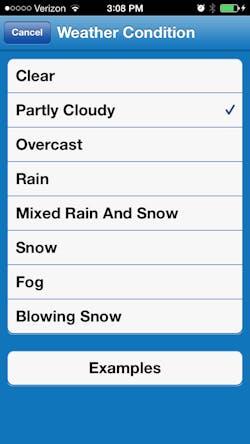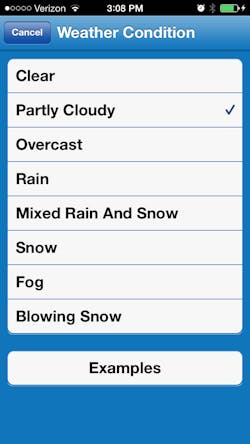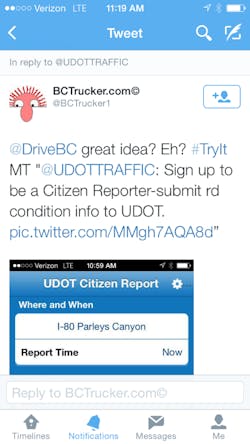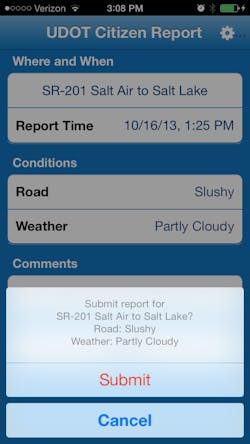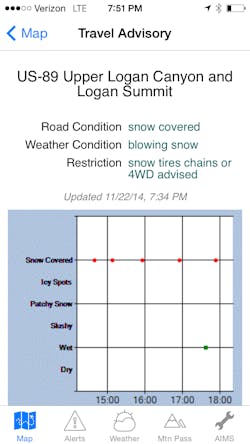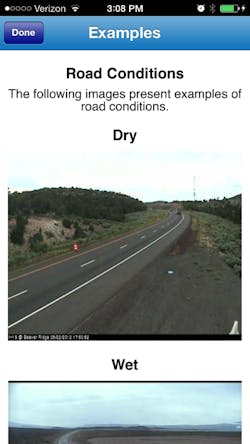Crowd noise
Current and forecast weather conditions are a critical part of traveler information in Utah, a state that has many high mountain passes and rural routes that frequently experience hazardous winter weather. Accurate road-condition information for these routes is vital for traveler safety and route planning. Some of Utah’s critical rural routes also carry a large amount of freight traffic.
The Citizen Reporter app allows drivers and road workers to inform UDOT of roads conditions in real time.
The Utah Department of Transportation (UDOT)’s Citizen Reporters help to enhance coverage of road-weather reporting by providing data on road segments throughout the state of Utah. UDOT has a network of road weather information stations (RWIS), traffic cameras and traveler-information meteorologists that help to create road conditions reports. UDOT also utilizes reports from snow-plow crews.
The UDOT Citizen Reporting Program enlists volunteers to report on current road conditions along specific roadway segments across Utah. The volunteers can be UDOT employees, law enforcement, truck drivers, plow drivers, experienced commuters or other volunteers. The long-term goal of adding Citizen Reporters to UDOT’s weather operations road reporting is to supplement current condition reporting on segments where drivers are already traveling. The UDOT Citizen Reporter app is the first of its kind for a state DOT. Other states have implemented citizen-reported data programs; however, those programs are web-based.
They were contacting us
Prior to the Citizen Reporter Program, road-weather reporting occurred through observations of snow-plow drivers and operators at the UDOT Traffic Operations Center. Regionally significant and high-volume state routes are broken into a total of 140 reporting segments. TOC operators report on 11% of the segments, mostly urban, using visual observations from traffic cameras. This occurs on an hourly basis. The remaining 89% of segments, mostly rural, are reported on by UDOT field personnel, at least twice daily and when conditions change, if they are aware of the change. Stale and incorrect reports often result from lags in reporting from field personnel; when road reports are several hours old, motorists conveyed to UDOT that they did not know if they could trust and rely on the reports.
Citizens were beginning to contact UDOT through social media with their observations. While this information is valuable, it is sometimes difficult to verify. Also, without a specific conduit, some information was used and some was not. Citizens have been reporting their observations to weather-reporting agencies like the National Oceanic and Atmospheric Association (NOAA) and the National Weather Service through existing weather-spotter apps.
Once UDOT had a concept for the project, it partnered with the Federal Highway Administration’s Weather Responsive Traffic Management (WRTM) team for funding and guidance for the project. Reliable traveler information is always important; however, during storms there are additional elements that need to be considered, including type of vehicle, safety and duration of the event.
Large, mostly rural states like Utah struggle to provide statewide current road conditions to travelers. UDOT relies heavily on observations by its snow-plow drivers, but workload during a storm limits their availability to update road-weather reports. It is not feasible to instrument every segment of roadway. UDOT’s staff meteorologists attempt to supplement the observations of plow drivers, but they can only do so for segments with available data and they do not have eyes on the road to verify their interpretations. These realities often mean that UDOT cannot provide current road-weather information because the agency simply does not have it.
An unintentional benefit of the Citizen Reporter program app is the ability for plow drivers to be able to submit their reports from a smartphone. Prior to the Citizen Reporter program app being developed, UDOT plow crews submitted their required reports through a desktop web interface or a phone-in platform. Both were cumbersome and presented challenges. Now, UDOT plow crews can report their required observations without leaving the cab of their plow.
An obvious supplementary source of current road-weather data is citizens with firsthand knowledge. The UDOT Citizen Reporter Program is intended to enhance UDOT’s coverage of road-weather reporting on under-reported segments throughout the state. The vast majority of these segments are in rural areas. The program serves the public in two ways—by providing a tool for individuals to contribute to the process and by collecting and disseminating the best possible road-weather information to travelers.
Almost all accurate
A survey of UDOT Citizen Reporter volunteers was conducted in the summer of 2014. Volunteers reported that they think the program is valuable and are thankful that UDOT created a conduit for them to submit their observations. Some volunteer reporters requested a reminder pop-up in order to submit their reports once they reach a safe reporting location.
“UDOT sees the Citizen Reporter Program as a long-term solution to the need for road-weather data. Crowd-sourcing is emerging as an effective means to both engage and serve the public. We anticipate the program to continue to gain in popularity,” said Lisa Miller, UDOT’s Traveler Information Manager. “We are capitalizing on the novelty of being able to report through an app, which is a newer occurrence in the world of traffic management.”
UDOT’s Citizen Reporter program was successfully pilot tested during the 2012-2013 winter season, using less than 100 UDOT-only volunteer reporters. The winter of 2013-2014 saw the pool of reporters broaden to the general public and the total number of reporters surged to 500. At the start of the 2014-2015 season, UDOT had 560 reporters, with more citizens signing up to report road and weather conditions with every storm.
The Citizen Reporter Program has the potential to exponentially increase the number of reports received on each road segment by giving the public the ability to report their observations. For the 2013-2014 winter season, the UDOT Citizen Reporter program contributed over 1,800 reports, which covered 143 of the 145 road segments.
An early concern was that the incoming data might not be reliable. Over the course of the pilot year and first full program year, sampling found the incoming data to be better than 99% accurate. Online training is required prior to volunteers being allowed to submit observations. The training discusses the intent of the program and stresses that reporters should never report while driving.
Many departments of transportation are exploring the idea of crowd-sourcing data for traveler information; however, there are perceived issues with data quality and accuracy. UDOT was able to maintain quality citizen-reported data by requiring the training session and specific login information for each volunteer. This project could help to lay the groundwork for other crowd-sourced data.
Data decision-making
Crowd-sourcing is not a common practice for state DOTs. This project was initially uncomfortable for UDOT as an organization, but demonstrated success strongly suggests that crowd-sourcing will be a part of UDOT’s future outreach and data gathering. UDOT is exploring other possible applications and benefits. Because of the nature of the training program, the data gathered and the pool of volunteers, there are no plans to expand the UDOT Citizen Reporter program to allow for other reports.
“UDOT has a successful app that allows motorists to report potholes and other road concerns. This app is independent from the UDOT Citizen Reporter app and does not require training or account creation, therefore UDOT made the decision to keep the apps separate,” said Miller.
UDOT also has a data-sharing partnership with Google/Waze and envisions a future component for motorists to be able to report road concerns through that interface.
UDOT now has available an entirely new set of data that is ongoing, quality-controlled and informative. The conduit created by this Citizen Reporter program gives the public the ability to reach out and submit data in a new way that was not available to them before. Citizen Reporter volunteers like to see their contribution on a public-facing graph. Each color represents a road and weather condition, whereas each square represents one citizen, plow or meteorologist report. A member of the public can essentially track the movement of a storm and UDOT’s ability to maintain clear roads through this project.
The future of ITS lies heavily in the efficient use of data. State DOTs must find new and innovative ways to collect, analyze and share data with partners and customers. The UDOT Citizen Reporter Program is demonstrating that crowd-sourcing is one effective way to accomplish this objective.
The Citizen Reporter Program enhances the road-weather information available to travelers when stakes are highest—during inclement weather. For more information on the program, visit www.udottraffic.utah.gov/citizenreporting. R&B
